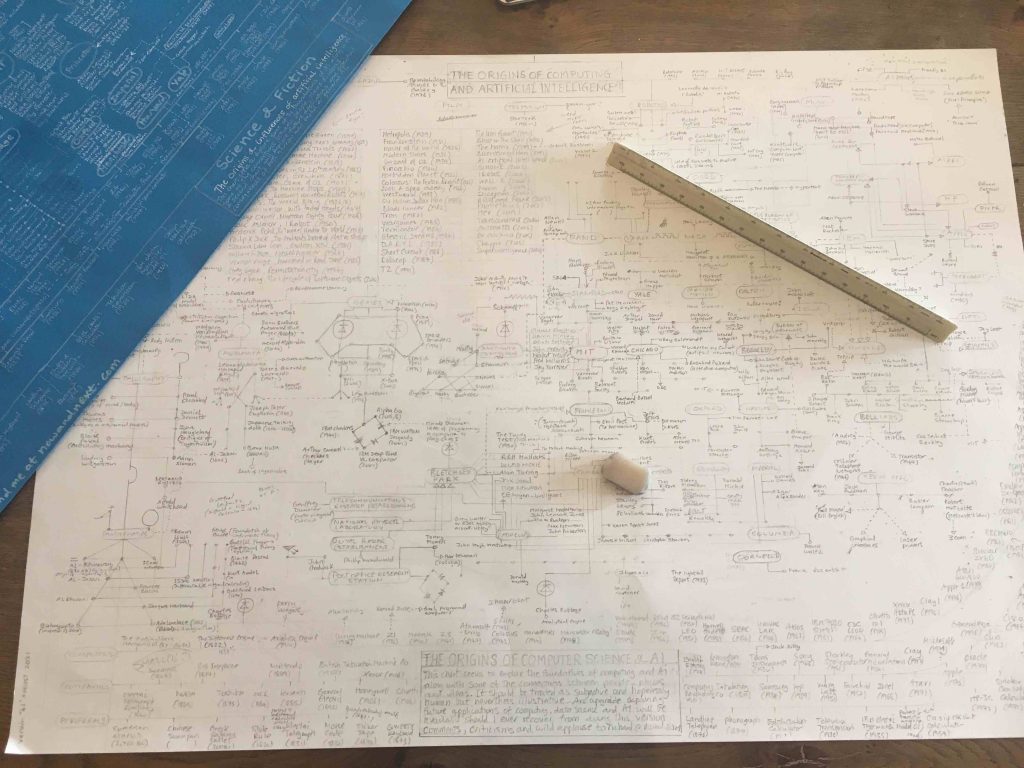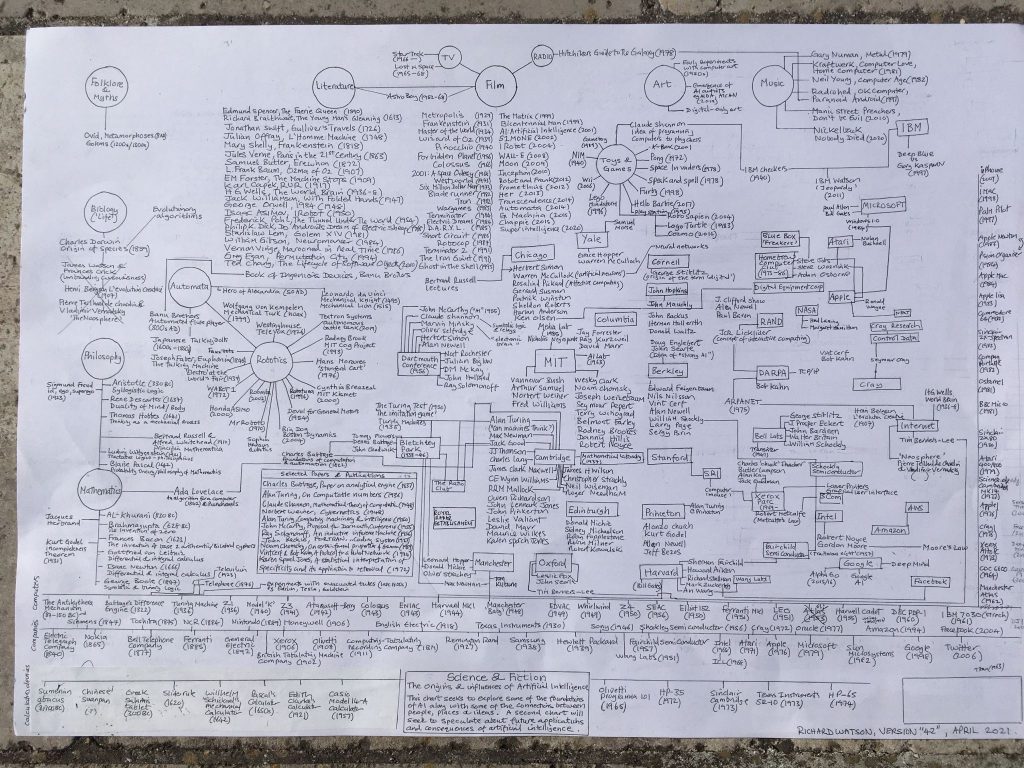Give me a week….


I think I’m getting somewhere with this. I often find that before looking forwards at the future of something, artificial intelligence, for example, it’s often worth going backwards to the start of things. This is a draft of a visual looking at the history and influences of computing and AI.
It needs a sense check, contains errors and is somewhat western-centric, but then I am all of these things. It’s also very male-heavy, but then that was the world back then – and in AI and IT possibly still is. Perhaps I should do a visual showing women in AI – starting with women at Bletchley Park, NASA and so on. I may spin this off into a series of specific maps looking purely at robotics or software too.

There’s an interesting short film about what some of Microsoft’s products might look like in ten years time. The film was used by Stephen Elop, Microsoft’s Business Division President, at the Wharton Business School Technology Conference last week.
http://venturebeat.com/2009/02/28/this-is-the-microsoft-i-want-to-see/
10.Simplicity
What is it?
A trend that’s sweeping through the technology industry is simplicity. Many products are over-engineered and feature a myriad of functions, 90%+ of which people never use. A survey by the Consumer Electronics Association in the US found that 87% of people cited ease of use as the most important feature of any new technology product. Another survey find that a substantial percentage of products returned to a retailers as ‘faulty’ were in fact in perfect working order — it was just that they were so complicated that users couldn’t figure them out.
Opportunities:
Making things (including companies) as simple as possible. For example, Philips has simplified itself by reducing the number of businesses it runs from 500 to 70 and has similarly reduced the number of divisions to 5 from 50.
Products, product ranges and pricing can be made less complicated and so too can the language that is used in external and internal communications.
Risks:
Populations are ageing and so the demand for easy to understand and simple to use products should accelerate in the future. Companies that do not offer simplified products will find that customers will shift their loyalty and allegiance to companies that do.
9.Too Much Information
What is it?
Information is no longer power. People are drowning in information caused by the level of global connectivity and digitalization. The media trend of user-generated content, together with the widespread adoption of location aware devices such as GPS-enabled mobile phones, will make this situation even worse in the future.
Parallel to this outbreak of content confusion, individuals are becoming disorientated by the amount of choice that is now available in every market from laptops to toothpaste. In short, people have never had so much choice but equally they have also never had less time. The result is the emergence of the ‘attention economy’, where people trade their limited time and attention for economic benefit.
Opportunities:
Using software and machines to reduce complexity. Also software and services that filter, sift or edit large amounts of information.
Risks:
Decision paralysis caused by too much information.
7. Rise of the Machines
What is it?
In the future, chips will be embedded in almost everything and almost everything will know where it is. While true artificial intelligence is still a long way off, we are already seeing the emergence of increasingly intelligent machines that can ‘talk’ to each other. We are also seeing machines that can ‘recognise’ individual users and machines that can work out what mood a user is in and adjust themselves accordingly.
The consequences of this are significant. First people and objects will be monitored and measured from afar. Items with digital components will be remotely serviced or upgraded while other devices will be able to certify that something is what it says it is — everything from people and machine parts to food and bottles of medicine will carry a digital trace of where they’re from and, perhaps, where they’re been.
Opportunities:
The use of machines to speed up transactions, predict what people want (often before the person knows themselves) and devices that adapt themselves to the user rather than the other way around.
Risks:
People could grow increasingly uncomfortable with machines that seemingly know everything about them. There could also be a flight away from high-tech to high-touch, especially if the economy turns sour.
6.Open Innovation
What is it?
A trick borrowed from the open-source software movement. Companies are wising up to the fact that none of their employees is as smart as all of their employees. Really smart companies are also looking at innovation in terms of open networks and are engaging in highly collaborative relationships with communities of suppliers and customers.
Opportunities:
Getting closer to customers and suppliers, speeding up the innovation process, fast feed-back loops. The open model could also be a template for what the firm of the future might look like. For example, Mozilla Corporation has around 100 employees and almost 200,000 volunteer helpers.
Risks:
Decision paralysis caused by too much information and/or too many ideas. Also managing the expectations of people that have been brought into the innovation process. There are also latent legal risks with regard to openly created intellectual property.
5.Shopping 2.0
What is it?
Social media is blending with e-commerce to create what’s being called social shopping or shopping 2.0. In the real world, shopping is an event. It is an experience, often shared, and people listen to the recommendations of friends and trusted experts. At least women do.
This fact has not escaped the attention of various r(e)-tail entrepreneurs and we are starting to see the emergence of sites like Crowdstorm, ThisNext, Karboodle, woot, zebo and Stylehive that tap into various social networking principles and allow friends to discuss particular shops, review or vote on specific products or shop as a virtual group in real time. Price comparisons are also easy and, crucially, there is the opportunity to form large groups
to buy quantities of specific products, negotiating a great deal along the way.
Opportunities:
Using technology to make the online shopping experience more real (e.g. the use of haptics). In general this means making the experience more fluid, with less emphasis on scrolling through pages of text. Also using social networks to allow people to share shopping experiences, recommend particular products or shop as part of a group.
Risks:
Data theft, ID theft, online fraud, consumer concerns surrounding digital privacy.
4.Virtualisation
What is it?
As physical movement becomes more difficult and more expensive, companies such as Intel, Hewlett-Packard and Crayola are setting up virtual offices and virtual meetings rooms to allow employees to communicate and interact. This is happening in other spheres too. In education, students are downloading lectures so they don’t have to show up in person, while cyberspaces are also being used for training purposes and data storage.
Opportunities:
Virtual meetings can reduce carbon footprints. Digital meetings can also be stored, or even downloaded onto an iPod or computer, so that they can be ‘attended’ at a later date. Remote data back-up and secure storage is also emerging as an opportunity within the home.
Risks:
Virtual meetings are not carbon-free (they still use electricity) and having an avatar attend a meeting can mean that people miss vital clues such as body language. Equally, doing away with physical office space entirely is possibly a bad idea because there is still a need for people to physically interact if you want to achieve any meaningful sense of community.